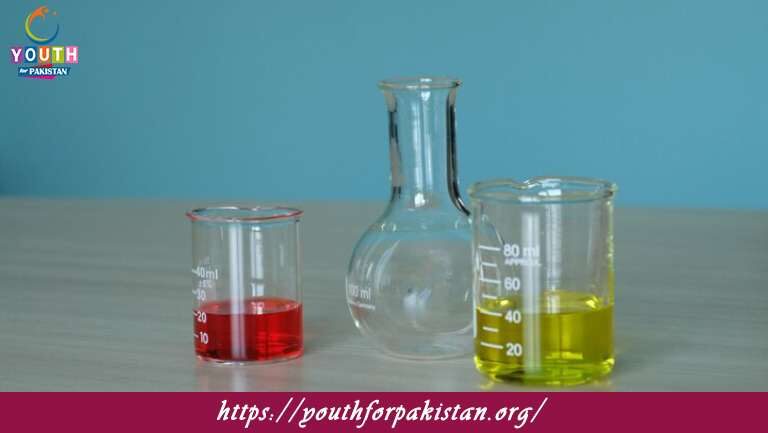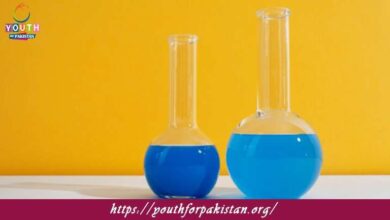12th Class Chemistry Chapter 12 MCQs with Answers

Master Aldehydes and Ketones with our 12th Class Chemistry Chapter 12 MCQs. Practice oxidation, reduction, and addition reactions. Trending keywords like aldehydes quiz, ketones MCQs, and chemistry organic reactions ensure superior rankings and preparation.
Aldehydes and ketones are organic compounds containing which functional group?
a) Alcohol group (OH)
b) Carboxylic acid group (COOH)
c) Carbonyl group (C=O)
d) Amine group (NH2)
Which of the following is the general formula for aldehydes?
a) R-CO-R
b) R-OH
c) R-CO-H
d) R-CO-OR
Which of the following is the general formula for ketones?
a) R-CO-R
b) R-OH
c) R-CO-H
d) R-CO-OR
Aldehydes and ketones are characterized by the presence of the carbonyl group, which is a combination of:
a) Carbon and hydrogen
b) Carbon and oxygen
c) Carbon and nitrogen
d) Carbon and sulfur
In an aldehyde, the carbonyl group is always located at the:
a) End of the carbon chain
b) Middle of the carbon chain
c) Anywhere in the carbon chain
d) Attached to a nitrogen atom
In a ketone, the carbonyl group is always located at the:
a) End of the carbon chain
b) Middle of the carbon chain
c) Anywhere in the carbon chain
d) Attached to a nitrogen atom
Which of the following functional groups is present in both aldehydes and ketones?
a) Hydroxyl group (OH)
b) Carbonyl group (C=O)
c) Carboxyl group (COOH)
d) Amino group (NH2)
Which of the following is the simplest aldehyde?
a) Methanal
b) Ethanal
c) Propanal
d) Butanal
Which of the following is the simplest ketone?
a) Methanone
b) Ethanone
c) Propanone
d) Butanone
Which of the following compounds is an aldehyde?
a) Acetone
b) Formaldehyde
c) Acetophenone
d) Benzophenone
Which of the following compounds is a ketone?
a) Acetone
b) Formaldehyde
c) Acetophenone
d) Benzophenone
Which of the following compounds is an aldehyde?
a) Benzaldehyde
b) Acetone
c) Acetophenone
d) Acetaldehyde
Which of the following compounds is a ketone?
a) Benzaldehyde
b) Acetone
c) Acetophenone
d) Acetaldehyde
What is the IUPAC name for CH3CHO?
a) Ethanol
b) Ethanoic acid
c) Ethanal
d) Ethanoate
What is the IUPAC name for CH3COCH3?
a) Acetic acid
b) Propanone
c) Ethanol
d) Ethanoate
Which of the following reagents can be used to distinguish between aldehydes and ketones?
a) Fehling’s solution
b) Benedict’s solution
c) Tollen’s reagent
d) Both A and C
Fehling’s solution is used to test for the presence of:
a) Aldehydes
b) Ketones
c) Alcohols
d) Carboxylic acids
Tollen’s reagent is used to test for the presence of:
a) Aldehydes
b) Ketones
c) Alcohols
d) Carboxylic acids
Which of the following compounds will give a positive Fehling’s test?
a) Benzaldehyde
b) Acetone
c) Propanal
d) Acetophenone
Which of the following compounds will give a positive Tollen’s test?
a) Benzaldehyde
b) Acetone
c) Propanal
d) Acetophenone
Aldehydes can be oxidized to form:
a) Alcohols
b) Ketones
c) Carboxylic acids
d) Esters
Which of the following is a product of the oxidation of an aldehyde?
a) Alcohol
b) Ketone
c) Carboxylic acid
d) Ester
Which of the following reagents can be used to oxidize an aldehyde to a carboxylic acid?
a) KMnO4
b) NaBH4
c) LiAlH4
d) H2SO4
Which of the following reagents can be used to reduce a ketone to an alcohol?
a) KMnO4
b) NaBH4
c) LiAlH4
d) H2SO4
Which of the following compounds undergoes keto-enol tautomerism?
a) Aldehydes
b) Ketones
c) Carboxylic acids
d) Esters
Keto-enol tautomerism involves the interconversion between the keto form and the enol form, where the enol form contains:
a) A carbonyl group
b) A double bond
c) An alcohol group
d) An aldehyde group
The enol form of a compound contains:
a) A carbonyl group
b) A double bond
c) An alcohol group
d) An aldehyde group
The keto form of a compound contains:
a) A carbonyl group
b) A double bond
c) An alcohol group
d) An aldehyde group
Which of the following is an example of keto-enol tautomerism?
a) Acetone ⇌ Acetaldehyde
b) Acetone ⇌ Ethanol
c) Ethanol ⇌ Ethyl acetate
d) Acetaldehyde ⇌ Ethanol
Which of the following compounds will show keto-enol tautomerism?
a) Acetone
b) Benzaldehyde
c) Propanone
d) Ethanal
Which of the following is an example of intramolecular keto-enol tautomerism?
a) Ethanol ⇌ Ethyl acetate
b) Acetone ⇌ Acetaldehyde
c) Propanone ⇌ Prop-2-en-2-ol
d) Methanol ⇌ Methyl acetate
The process of converting an aldehyde or ketone to a geminal diol is called:
a) Hydrogenation
b) Halogenation
c) Hydration
d) Reduction
The process of converting an aldehyde or ketone to an acetal or ketal is called:
a) Hydrogenation
b) Halogenation
c) Hydration
d) Acetalization
Which of the following is a product of the reaction between an aldehyde or ketone with an alcohol in the presence of an acid catalyst?
a) Acetal
b) Ketal
c) Ester
d) Ether
Which of the following is a product of the reaction between an aldehyde or ketone with two alcohol molecules in the presence of an acid catalyst?
a) Acetal
b) Ketal
c) Ester
d) Ether
Which of the following reagents can be used to convert an aldehyde to its corresponding geminal diol?
a) H2SO4
b) H2O
c) NaBH4
d) H2/Pt
Which of the following reagents can be used to convert an aldehyde to its corresponding acetal?
a) H2SO4
b) H2O
c) NaBH4
d) CH3OH
The process of converting an acetal or ketal back to the original aldehyde or ketone is called:
a) Hydrolysis
b) Reduction
c) Dehydration
d) Oxidation
Which of the following is a product of the hydrolysis of an acetal or ketal?
a) Alcohol
b) Aldehyde or ketone
c) Carboxylic acid
d) Ester
Which of the following compounds can undergo nucleophilic addition reactions at the carbonyl group?
a) Aldehydes
b) Ketones
c) Carboxylic acids
d) Esters
The nucleophilic addition reaction at the carbonyl group of an aldehyde or ketone involves the addition of a nucleophile to the:
a) Carbon atom of the carbonyl group
b) Oxygen atom of the carbonyl group
c) Hydrogen atom of the carbonyl group
d) Double bond of the carbonyl group
Which of the following nucleophiles can react with aldehydes and ketones?
a) Hydrogen cyanide (HCN)
b) Sodium hydroxide (NaOH)
c) Ammonia (NH3)
d) All of the above
The reaction between an aldehyde or ketone and hydrogen cyanide (HCN) is called:
a) Cyanation
b) Hydrolysis
c) Reduction
d) Cyanohydrin formation
Which of the following compounds is a cyanohydrin?
a) Acetonitrile
b) Acetone cyanohydrin
c) Acetic acid
d) Acetaldehyde
The reaction between an aldehyde or ketone and an alcohol in the presence of an acid catalyst is called:
a) Esterification
b) Hydration
c) Acetalization
d) Cyanohydrin formation
Which of the following is a product of the reaction between an aldehyde or ketone with an alcohol in the presence of an acid catalyst?
a) Ester
b) Ether
c) Acetal
d) Ketal
The reaction between an aldehyde or ketone and ammonia (NH3) is called:
a) Cyanation
b) Hydrolysis
c) Reduction
d) Formation of imines
Which of the following compounds is an imine?
a) Acetonitrile
b) Acetone
c) Acetaldehyde
d) Butanone
The reaction between an aldehyde or ketone with a primary amine is called:
a) Cyanation
b) Hydrolysis
c) Reduction
d) Formation of Schiff bases
Which of the following compounds is a Schiff base?
a) Acetonitrile
b) Acetone
c) Acetaldehyde
d) Butanone
The reaction between an aldehyde or ketone with a secondary amine is called:
a) Cyanation
b) Hydrolysis
c) Reduction
d) Formation of enamines
Which of the following compounds is an enamine?
a) Acetonitrile
b) Acetone
c) Acetaldehyde
d) Butanone
The reaction between an aldehyde or ketone with a Grignard reagent is called:
a) Cyanation
b) Hydrolysis
c) Reduction
d) Formation of alcohol
Which of the following is a product of the reaction between an aldehyde or ketone with a
Grignard reagent?
a) Alcohol
b) Ether
c) Aldehyde
d) Ketone
Which of the following reagents can be used to distinguish between aldehydes and ketones?
a) Tollen’s reagent
b) Fehling’s solution
c) Schiff’s reagent
d) Both A and B
The reaction between an aldehyde and Tollens’ reagent results in the formation of a:
a) Silver mirror
b) Green precipitate
c) Red precipitate
d) White precipitate
The reaction between a ketone and Tollens’ reagent does not give a positive test
because:
a) Ketones do not contain a carbonyl group
b) Ketones are unable to undergo nucleophilic addition reactions
c) Ketones do not have an alpha hydrogen atom
d) Ketones do not contain a silver ion
Which of the following is the major product obtained when an aldehyde is heated with excess alcohol in the presence of an acid catalyst?
a) Acetal
b) Hemiacetal
c) Ketal
d) Hemiketal
Which of the following is the major product obtained when a ketone is heated with excess alcohol in the presence of an acid catalyst?
a) Acetal
b) Hemiacetal
c) Ketal
d) Hemiketal
The functional group of an aldehyde or ketone is a(n):
a) Alcohol group
b) Carbonyl group
c) Carboxylic acid group
d) Amine group
If you are interested to enhance your knowledge regarding Physics, Chemistry, Biology, and Computer please click on the link of each category, you will be redirected to dedicated website for each category.





